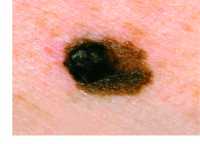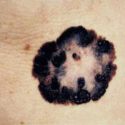
08 Feb Melanoma Rates Stable in Australia but Rising in US
MedicalResearch.com Interview with:

Example of one type of melanoma
Dr. Catherine M. Olsen
Associate Professor
Cancer Control Group
QIMR Berghofer Medical Research Institute
MedicalResearch.com: What is the background for this study?
Response: Melanoma incidence and mortality rates are increasing globally. Public health campaigns aiming to reduce sun exposure and use of sunbed have been implemented in many parts of the world, but there is significant variability in terms of the history and reach of these campaigns across countries. We examined melanoma incidence rates in eight different countries with different patterns of sun exposure and varying approaches to melanoma control.
MedicalResearch.com: What are the main findings?
Response: Our study of the most recent melanoma incidence figures show that melanoma rates have plateaued in Australia since about 2005 and in Denmark more recently. In New Zealand, rates have been declining since around 2008 at a rate of 1.3% per annum. The incidence rates have continued to rise in all of the other population groups studied, including the United States Caucasian population, the United Kingdom, Canada, Sweden and Norway at rates of between 1.7 percent and 4.8 percent per annum.
MedicalResearch.com: What should readers take away from your report?
Response: The fact that rates were no longer rising in New Zealand, Australia and Denmark is likely due to those countries taking more steps to implement community-wide skin cancer prevention programs.
Australia has a long history of coordinated and broad-reaching primary prevention campaigns, beginning in the early 1980s, whereas in the US, UK, Norway and Sweden such programs were implemented at least a decade later. In Demark, a national sun safety campaign was launched in 2007, and evaluations surveys have recorded a significant drop in sunbed use amongst younger Danes since the campaign began.
MedicalResearch.com: What recommendations do you have for future research as a result of this work?
Response: We need to keep monitoring these trends to understand the impact of control efforts in place in each country.
None to declare.
Citation:
Trends in Melanoma Incidence Rates in Eight Susceptible Populations through 2015
Catherine M.Olsen Adele C.Green NirmalaPandeya David C.Whiteman
Journal of Investigative Dermatology
Available online 19 December 2018
[wysija_form id=”3″]
[last-modified]
The information on MedicalResearch.com is provided for educational purposes only, and is in no way intended to diagnose, cure, or treat any medical or other condition. Always seek the advice of your physician or other qualified health and ask your doctor any questions you may have regarding a medical condition. In addition to all other limitations and disclaimers in this agreement, service provider and its third party providers disclaim any liability or loss in connection with the content provided on this website.
Last Updated on February 8, 2019 by Marie Benz MD FAAD
